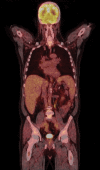Lesson of the month 2: When steroids stop working - infective endocarditis, the great mimicker
- PMID: 30651254
- PMCID: PMC6399638
- DOI: 10.7861/clinmedicine.19-1-82
Lesson of the month 2: When steroids stop working - infective endocarditis, the great mimicker
Abstract
A 63-year-old man with an extensive travel history to South East Asia presented with generalised malaise, temporal headaches and high inflammatory markers. He was treated with corticosteroids for presumed giant cell arteritis. Unsuccessful attempts to wean him from prednisolone prompted further investigations by rheumatology, haematology and finally ophthalmology. Roth spots were identified which prompted blood cultures to be taken. All three sets grew Streptococcus sinensis, an alpha-haemolytic Streptococcus reported as an emerging cause of endocarditis worldwide. The patient had signs of severe aortic regurgitation, confirmed on transthoracic echo. A transoesophageal echo demonstrated large aortic valve vegetations. He underwent an aortic valve replacement and completed 6 weeks of intravenous antibiotics with resolution of his symptoms.This case illustrates the importance of challenging a previous diagnosis, including repeat examination, when a patient's condition does not evolve as expected. Endocarditis is recognised as a great imitator and the diagnosis remains challenging.
Keywords: Chronic infective endocarditis; Streptococcus sinensis; emerging infections.
© Royal College of Physicians 2019. All rights reserved.
Figures




Similar articles
-
Aortic valve aneurysm associated with infective endocarditis: case report and review of literature.Gen Thorac Cardiovasc Surg. 2017 Jul;65(7):408-414. doi: 10.1007/s11748-016-0681-9. Epub 2016 Jul 2. Gen Thorac Cardiovasc Surg. 2017. PMID: 27372074 Review.
-
Isolated Left Atrial Infective Mural Endocarditis.Intern Med. 2018 Apr 1;57(7):957-960. doi: 10.2169/internalmedicine.9559-17. Epub 2017 Dec 8. Intern Med. 2018. PMID: 29225261 Free PMC article. Review.
-
Transoesophageal echocardiographic diagnosis of aortico-left atrial fistula in aortic valve endocarditis.Eur J Echocardiogr. 2003 Sep;4(3):221-2. doi: 10.1016/s1525-2167(02)00138-5. Eur J Echocardiogr. 2003. PMID: 12928027
-
Group A streptococcus endocarditis in children: 2 cases and a review of the literature.BMC Infect Dis. 2019 Jan 31;19(1):102. doi: 10.1186/s12879-019-3736-6. BMC Infect Dis. 2019. PMID: 30704409 Free PMC article. Review.
-
Infective endocarditis caused by Streptococcus acidominimus.Am J Health Syst Pharm. 2019 Nov 13;76(23):1926-1929. doi: 10.1093/ajhp/zxz234. Am J Health Syst Pharm. 2019. PMID: 31628793
Cited by
-
A New Clinical Prediction Rule for Infective Endocarditis in Emergency Department Patients With Fever: Definition and First Validation of the CREED Score.J Am Heart Assoc. 2023 May 2;12(9):e027650. doi: 10.1161/JAHA.122.027650. Epub 2023 Apr 29. J Am Heart Assoc. 2023. PMID: 37119081 Free PMC article.
-
Infective Endocarditis Caused by Streptococcus Sinensis in a Patient with Bioprosthetic Aortic Valve: A Case Report and Literature Review.Infect Drug Resist. 2024 Jul 12;17:2957-2964. doi: 10.2147/IDR.S470483. eCollection 2024. Infect Drug Resist. 2024. PMID: 39045110 Free PMC article.
-
Case report: Infective endocarditis caused by Streptococcus sinensis: The first case in mainland China and literature review.Front Cardiovasc Med. 2022 Jul 22;9:935725. doi: 10.3389/fcvm.2022.935725. eCollection 2022. Front Cardiovasc Med. 2022. PMID: 35935614 Free PMC article.
-
Infective endocarditis caused by Streptococcus sinensis diagnosed with next-generation sequencing: a case report and literature review.BMC Infect Dis. 2025 Mar 27;25(1):425. doi: 10.1186/s12879-025-10837-2. BMC Infect Dis. 2025. PMID: 40148753 Free PMC article. Review.
-
Streptococcus sinensis causing infective endocarditis in the Netherlands: our experiences from the UK.Eur Heart J Case Rep. 2020 Aug 20;4(5):1-2. doi: 10.1093/ehjcr/ytaa177. eCollection 2020 Oct. Eur Heart J Case Rep. 2020. PMID: 33204942 Free PMC article. No abstract available.
References
Publication types
MeSH terms
Substances
Supplementary concepts
LinkOut - more resources
Full Text Sources
Medical

